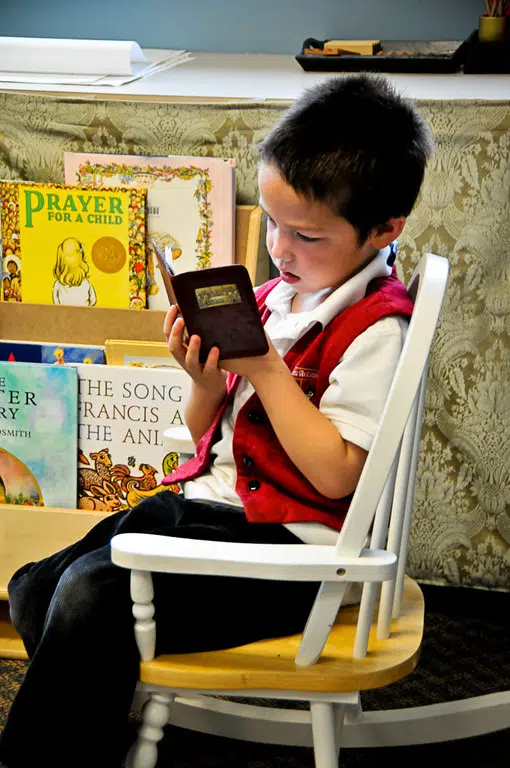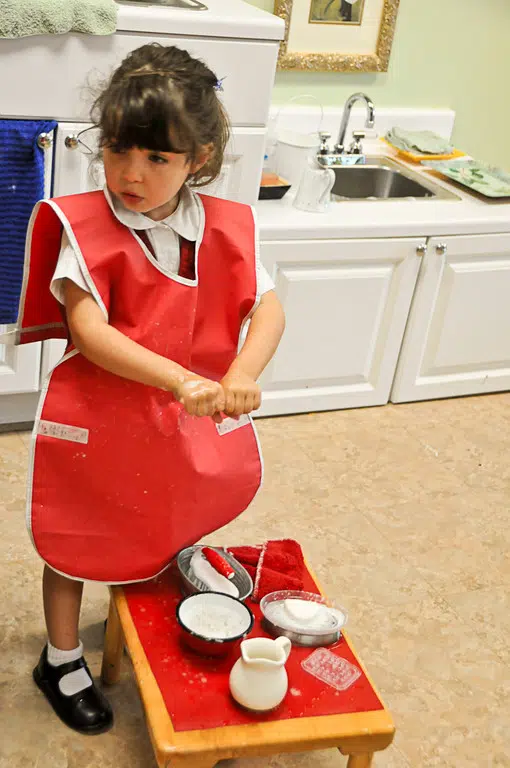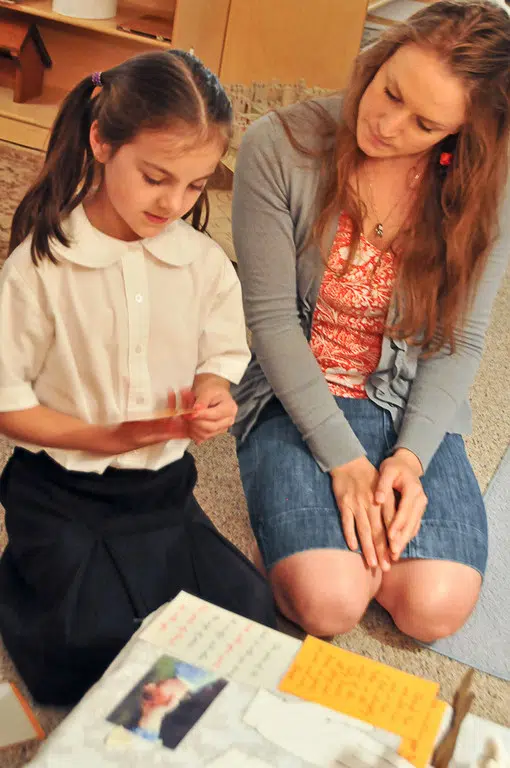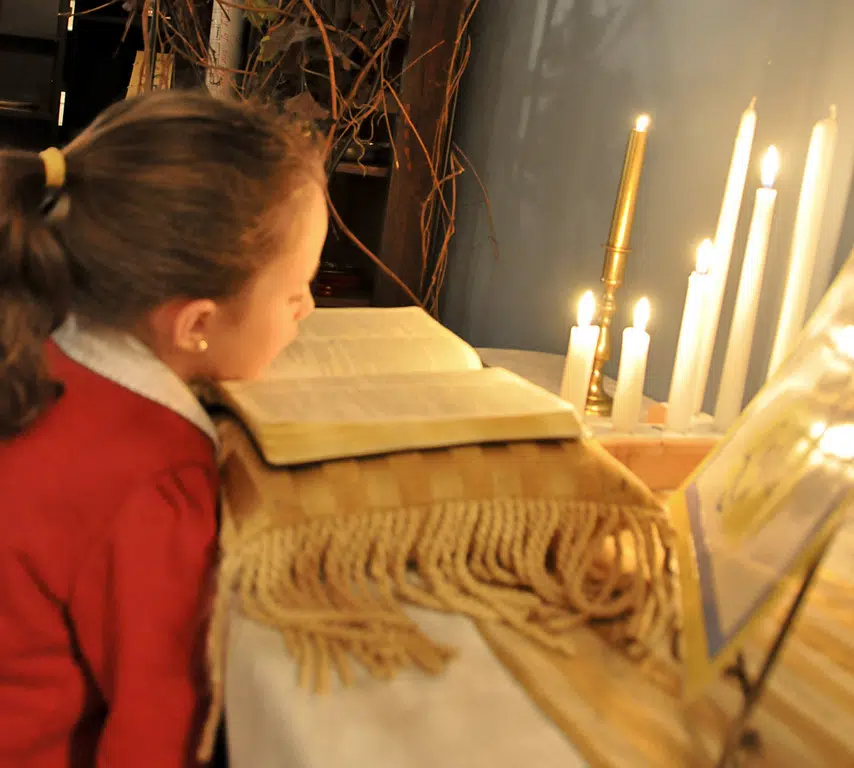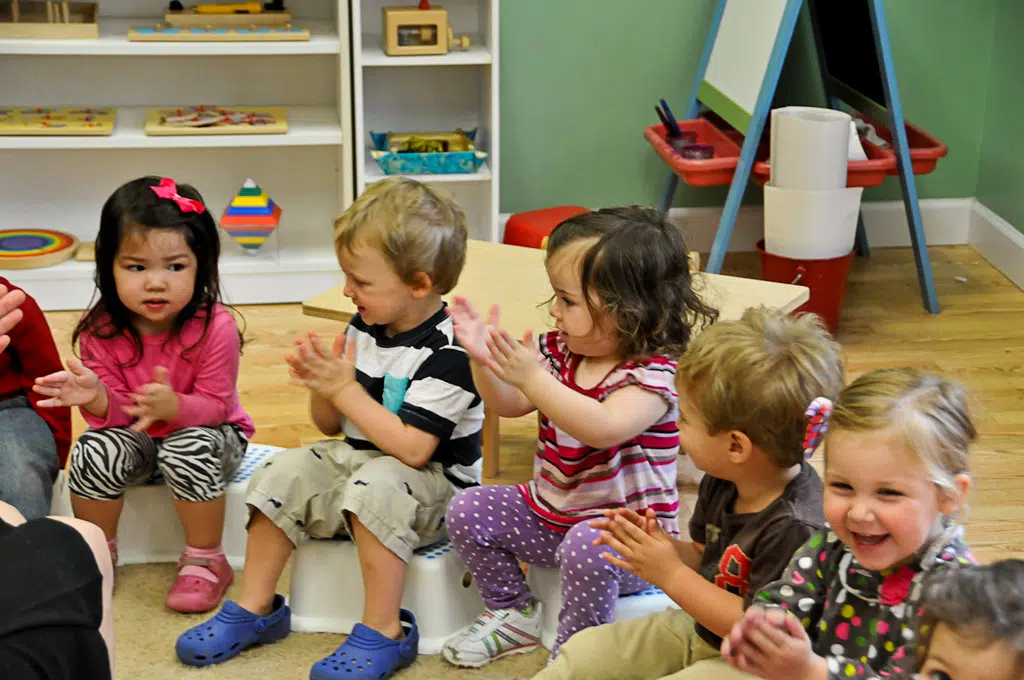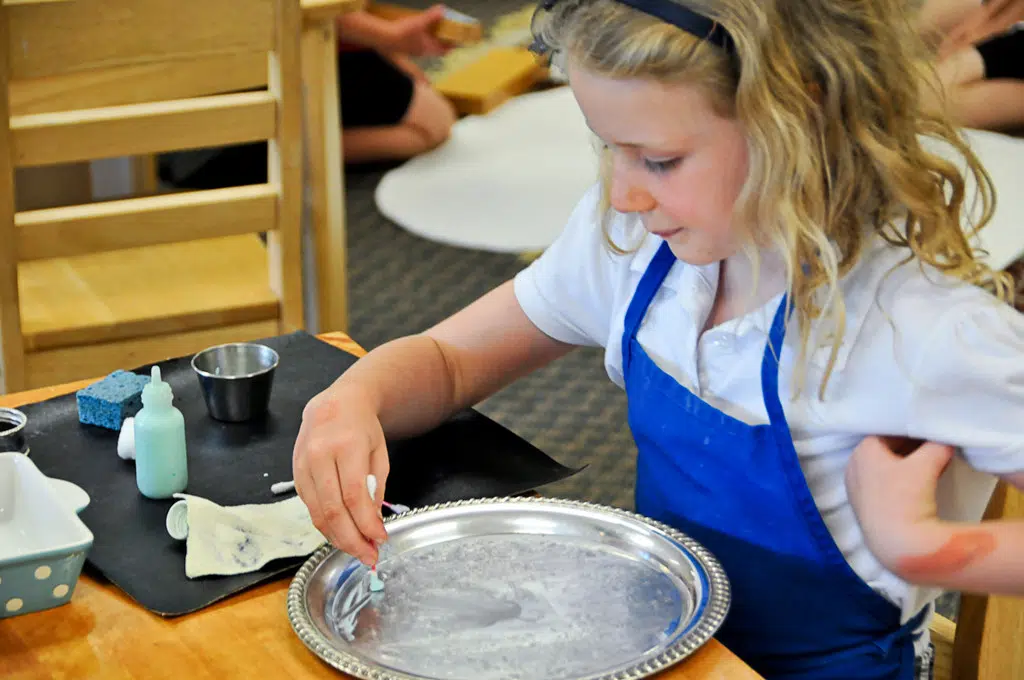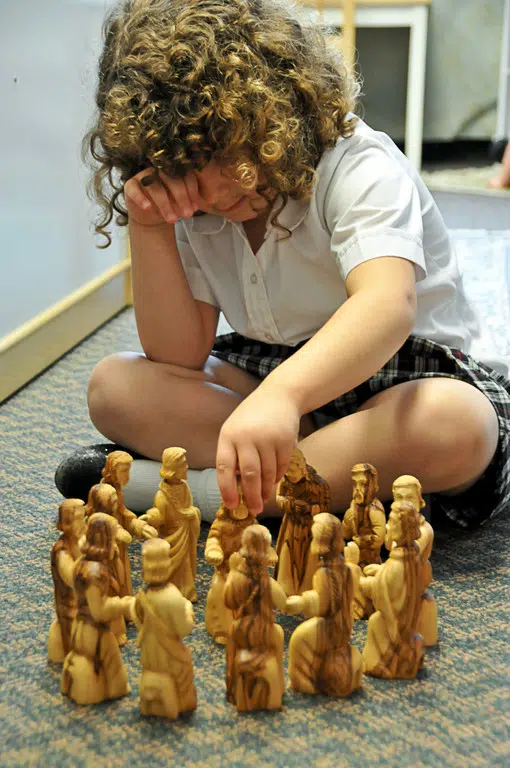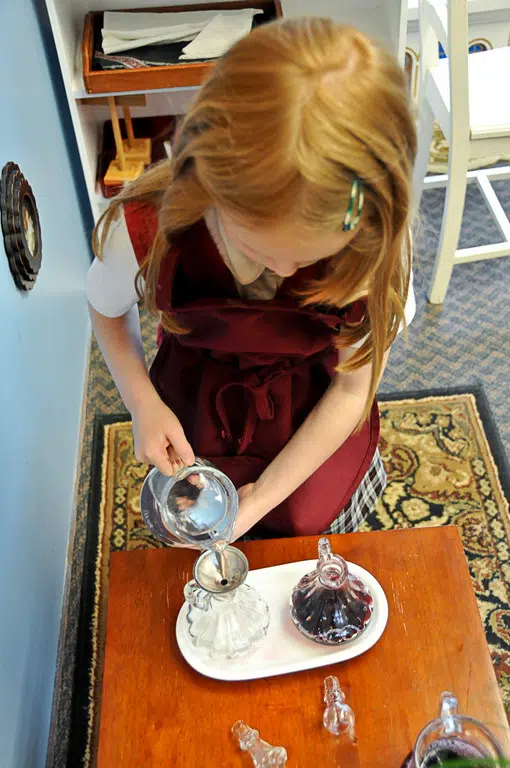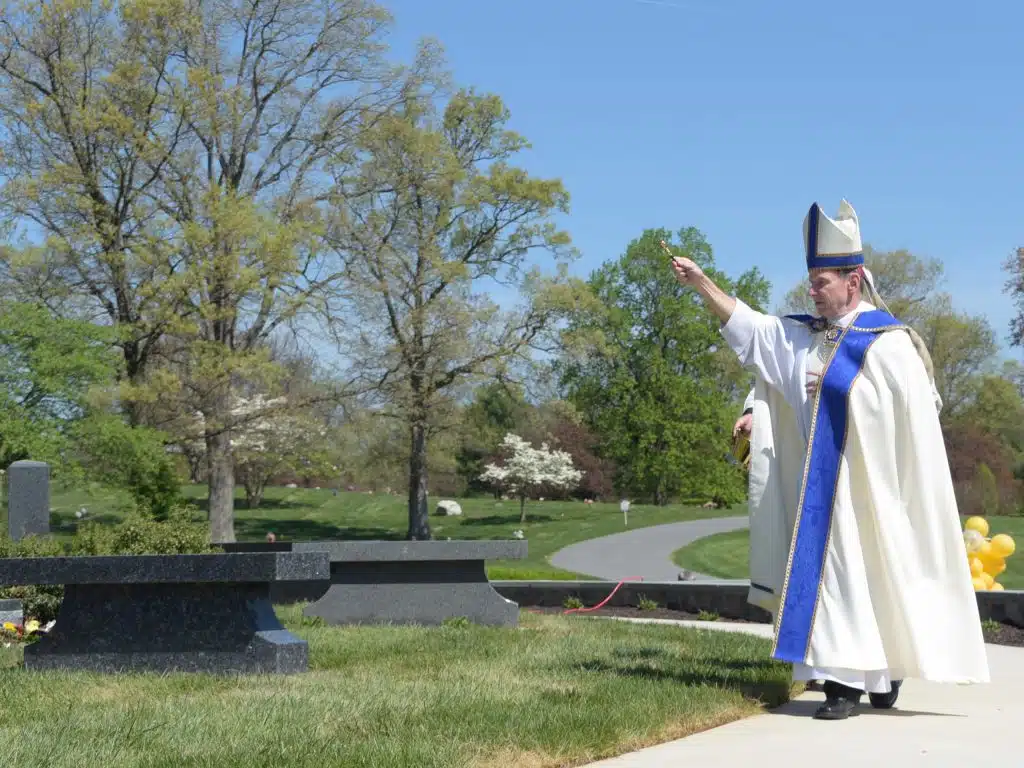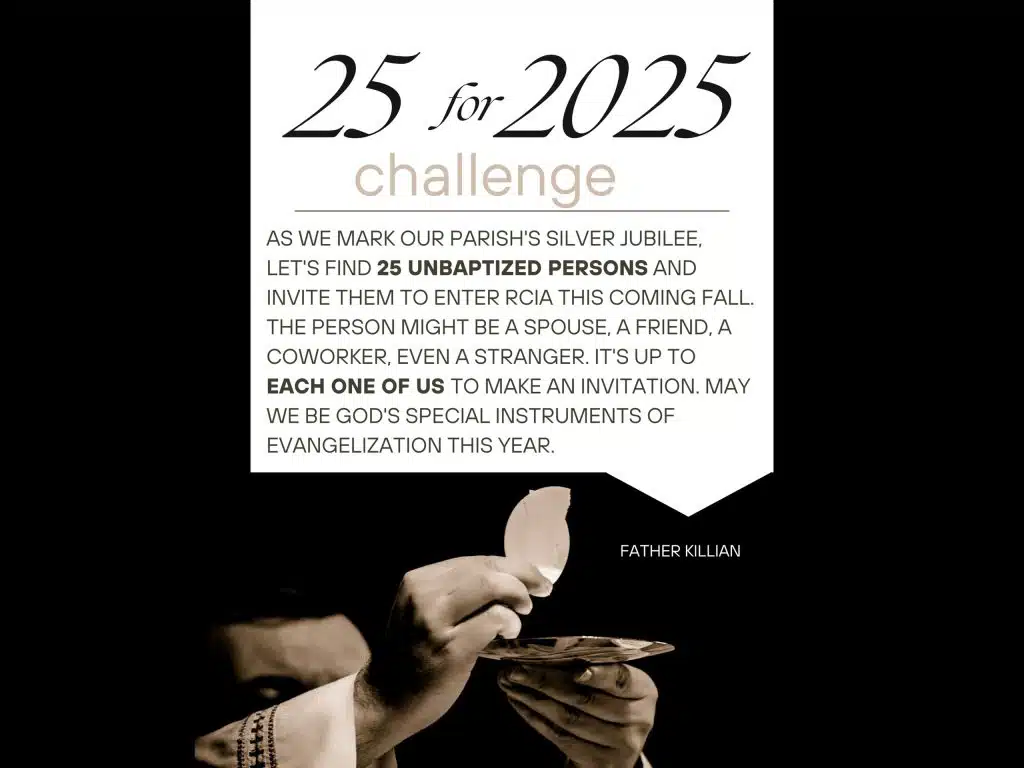Step into a classroom at Siena Academy, a Catholic Montessori
school in Great Falls, and rows of desks and a large
chalkboard are nowhere in sight. No hefty textbooks line the
shelves and no bell rings to signal a change in subjects.
Instead, a young boy reads cross-legged in a corner as
another arranges a map puzzle. A small girl concentrates as
she cuts strips of bright green paper while another squeezes
a wet sponge into a small sink. Some children are taller,
some a bit shorter; a few are chatty, others are quiet.
There’s a buzz of activity, but it’s primarily calm,
harmonious activity.
A renaissance
The Catholic Montessori classroom “is an environment
of children working together in harmony, in peace,” said
Siena parent Emily Costello. It’s also an environment that’s
attracting a growing number of Catholic families – nationally
and locally – for the kind of educational and spiritual
formation it provides.
“It’s experiencing a renaissance right now,” both in secular
and Catholic circles, according to David Kahn, executive
director of the North American Montessori Teachers’
Association (NAMTA). While it has existed since the early
20th century, Montessori is going through a wave of
popularity, much as it did in the late ’50s and early ’60s,
Khan said.
There are more than 4,000 private Montessori schools
nationwide and more than 200 public schools with
Montessori-styled programs, according to NAMTA. Many schools
are members of Association Montessori Internationale (AMI),
founded by Maria Montessori in 1929, which maintains her
educational principles, disseminates Montessori resources and
oversees training throughout the world.
In the late 1950s, Montessori’s friend Gianna Gobbi
collaborated with Sofia Cavaletti, a Hebrew and Scripture
scholar, to develop the Catechesis of the Good Shepherd, a
religious education program that draws upon Montessori’s view
of child development.
Not every Catholic Montessori school uses the catechesis for
religious formation, but it is the most popular and authentic
Montessori catechesis, according to Maggie Radzik, former
head of school at Siena.
While no official Catholic Montessori association exists,
many schools are members of the National Association of the
Catechesis of the Good Shepherd, based near Chicago, which
provides training and materials.
Association membership grew by 25 percent last year,
according to Rachel Faulman, director of business operations.
Parish religious education programs, home-schoolers and
traditional Catholic schools also use the Catechesis of the
Good Shepherd, and St. Rita School in Alexandria recently
started using it with preschoolers.
There are three Catholic Montessori schools within the
Arlington Diocese’s boundaries – Siena, a diocesan school;
and two schools unaffiliated with the diocese: John XXIII
Montessori Children’s Center, based at Human Life
International in Front Royal, and Renaissance School in
Manassas.
Siena has had a waiting list since it opened seven years ago,
according to Radzik. John XXIII, which opened 10 years ago,
receives more applications every year, said Laura Accettullo,
director and co-founder. And at 10-year-old Renaissance, Sean
Garvey, head of school, has observed similar growth.
“There’s been a big, big increase in interest and
enrollment,” said Garvey.
Garvey, part of an unofficial network of U.S. Catholic
Montessori schools that share ideas and support, said he’s
noticed the national trend.
Throughout the country, more established Catholic Montessori
schools report increased enrollment, including a17-year-old
Montessori School at Holy Rosary in Cleveland; 30-year-old
St. Helena Montessori in St. Helena, Calif.; and St.
Catherine’s Montessori in Houston, founded in 1966.
Montessori also has caught the attention of religious orders.
The Nashville Dominicans and the Missionaries of Charity are
trained in the catechesis, according to Mary Mirrione,
national director of the National Association of the
Catechesis of the Good Shepherd. She’s noticed a growing
interest from dioceses and seminaries.
Environments of discovery
Maria Montessori, the woman behind the educational
approach, was a lifelong, devout Catholic. Born in Italy in
1870, she was the first female physician in her country.
Montessori was nominated for the Nobel Peace Prize three
times, and her work in education and child development led
Alexander Graham Bell and his wife, Mabel, to invite her to
the United States in 1913. The Bells went on to found the
Montessori Educational Association in Washington D.C. Among
her other American supporters were Thomas Edison and Helen
Keller.
Montessori conducted clinical observations on how children
learn and concluded that they build their understanding of
the world from what they find in their environment.
Her educational method uses “prepared environments” where
learning materials are arranged for children to use for as
long as it holds their interest.
Classes are made up of multiage groups, typically broken up
into infant to age 3, 3-6, 6-9, 9-12 and 12-14.
Montessori believed there are four planes of human
development from birth to age 24. The first, from birth to
age 6, is characterized by intense change and growth when
children learn primarily through the senses. Within the
second, ages 6 to 12, they learn to work with abstractions
and become more social. In the third, ages 12 to 19, they
seek to understand their place in society. And in the fourth,
ages 18 to 24, they become more specialized learners and
pursue their niche in the world.
She believed children are naturally curious and that in the
proper setting they can make discoveries and teach
themselves.
The goal is for children to uncover skills and concepts on
their own, so younger children work with child-size tables,
sinks and brooms to learn practical life-skills, for example.
Older children are not presented theorems, but work to
discover them, and spelling rules are derived through
recognition of patterns, not memorized.
Independent activity makes up the majority of the school day,
said Radzik. Teachers give direction as briefly as possible,
“then they fade and observe,” she said.
To someone unfamiliar with the philosophy, it might appear a
Montessori classroom is unsupervised and the school day lacks
focus.
But each material is present to help cultivate a new skill or
insight, said Radzik. And if a child is using materials in an
aimless way, a teacher gently will redirect him or her to
different materials or to a more appropriate use of the
material.
There is a lot of activity in a classroom as children move
from one task to the next, but because they are self-directed
and engaged in what they are doing, classrooms tend to be
calm.
What most attracted Costello and her husband, Greg, to
Montessori, was its respect for the child. “It doesn’t create
a method and try to squish a child into it. Montessori is
trying to uncover and understand how God made the child,” she
said.
And Montessori’s observation-based conclusion that children
learn best through their senses has now been confirmed by
neuroscience, noted Costello.
Dr. Steven Hughes, president of the American Academy of
Pediatric Neuropsychology and chair of the AMI Global
Research Committee, was interviewed in March by NPR. During
the interview he discussed how Montessori’s sensory learning
has been shown to be the most effective way children learn.
“When you use your body to learn something, you will learn in
better,” he said.
“That’s how we are built to learn. … Part of the
genius of Montessori … (was not just) her
developmental instinct or philosophy,” but that she fleshed
out an educational method and created materials – “the tools
to help foster an interest in discovery.”
A quiet place to ‘be in love with God’
Along with academic discovery, the Catechesis of
the Good Shepherd fosters spiritual exploration and growth.
A central component of the catechesis is the “atrium,”
usually adjacent to the main classroom, with materials
intended to help children absorb the essential proclamations
of the Faith. Elements of an atrium include a statuette of
the Good Shepherd, a small altar and the furnishings used for
celebration of the Eucharist.
Montessori believed the atrium was the most special element
of a child’s learning environment, “for when you come into
it, you come into contact with Our Lord and with the seasons
of the Church,” said Radzik.
Children who participate in this catechesis come into “a deep
knowledge that they are called by name,” Radzik said. “The
depth of their relationship with God – you can’t put words to
it.”
“I’ve seen beautiful things with my children – they want to
spend time with God,” said Costello. She said they each have
an intimate, creative and lively relationship with God. When
her daughter was 5, she made up own meditations on the
Stations of the Cross.
Academically, Siena parent Linda Esquivel has witnessed some
of the long-term fruits of Montessori in her oldest son, who
graduated from Siena and now attends The Heights School, an
all-boys Opus Dei Catholic high school in Potomac, Md.
It took a while for him to adjust to a traditional school
setting, like sitting at a desk, but he’s received all A’s
and is thriving, she said, adding that he has a lot of
self-knowledge and strong sense of responsibility for his
education.
According to many Catholic families who have found it a good
fit, they are drawn to Catholic Montessori because it
nurtures the whole child, spiritually and academically, and
creates self-motivated, self-aware, confident children who
love to learn and have a deeply personal relationship with
God.
Mirrione believes that Catholic Montessori is especially
appealing – and important – because in a culture that is loud
and fast, it provides a calm and peaceful environment and an
opportunity where children can “be quiet and be in love with
God.”
“That’s something that’s always needed, but especially
today.”
Find out more
Angeline S. Lillard, a professor of psychology at
the University of Virginia, explores the science behind
Montessori’s system in Montessori: The Science behind the
Genius, available at montessori-science.org.
To learn more about the Catechesis of the Good Shepherd, go
to cgsusa.org
